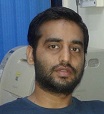3rd World Congress on GIS and Remote Sensing
Charlotte, USA

Keshav D Singh
University of California Davis, USA
Title: Hyperspectral Remote Sensing in Detection of Biotic and Abiotic Stresses in Plants for Precision Agriculture
Biography
Biography: Keshav D Singh
Abstract
Hyperspectral imaging (HSI), an emerging technology developed in recent years, integrates conventional imaging and spectroscopy knowledge to attain both spectral and spatial information from an object. Imaging spectroscopy provide detailed signatures (such as reflectance) of the biological samples due to interaction between the electromagnetic radiation and contact material. It is a powerful tool in studies of host selection by selected insects and abilities to assess crop health via reflectance profiling (detection of crop responses to biotic stressors for precision agriculture). Abiotic stresses are drought (water deficit), excessive watering (waterlogging/flooding), extreme temperatures (cold, frost and heat), salinity (sodicity) and mineral (metal and metalloid) toxicity negatively impacts growth, development, yield and seed quality of crop and other plants. For this study, the hyperspectral data of various agricultural plants are acquired using an airborne “true push-broom” hyperspectral camera [OCI Imager (OCI-UAV-D1000), BaySpec Inc.; 116 bands from 450-970nm] mounted on a drone (S1000 Premium Octocopter). The acquired images are generally affected by ground reflectance and atmospheric conditions, so the bidirectional reflectance were corrected using Radiative Transfer Equation (RTE) based Hapke’s model, addressing non-linear factors arises due to multiple scattering. The hypercube data were elaborated and analyzed by an algorithm coded under MATLAB environment. The final classified images show that it is possible to pinpoint the areas covered by stress plants prior to pesticide spray over whole agriculture field. It reduces the time, cost of spray and poisonousness in our biosphere.

